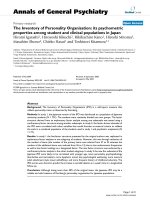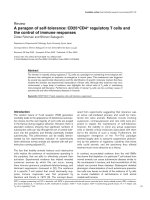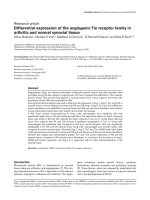Báo cáo y học: "Ocular Manifestations of Rickettsiosis: 1. Mediterranean Spotted Fever: laboratory analysis and case reports" potx
Bạn đang xem bản rút gọn của tài liệu. Xem và tải ngay bản đầy đủ của tài liệu tại đây (170.12 KB, 2 trang )
Int. J. Med. Sci. 2009, 6
126
I
I
n
n
t
t
e
e
r
r
n
n
a
a
t
t
i
i
o
o
n
n
a
a
l
l
J
J
o
o
u
u
r
r
n
n
a
a
l
l
o
o
f
f
M
M
e
e
d
d
i
i
c
c
a
a
l
l
S
S
c
c
i
i
e
e
n
n
c
c
e
e
s
s
2009; 6(3):126-127
© Ivyspring International Publisher. All rights reserved
Short Communication
Ocular Manifestations of Rickettsiosis: 1. Mediterranean Spotted Fever:
laboratory analysis and case reports
Antonio Pinna
Institute of Ophthalmology, University of Sassari, Sassari (Italy)
Published: 2009.03.19
Introduction
Rickettsiae are short, pleomorphic but usually
rod-shaped or coccobacillary Gram-negative bacteria
that grow strictly in eukaryotic cells (obligate intra-
cellular parasites). They have the ability to multiply in
one or more arthropods and to exist in natural reser-
voirs of one or several warm-blooded animal hosts,
including humans. Rickettsiae are divided into 5
groups: 1) Spotted fever group, including R. rickettsii,
R. conorii, and R. akari; 2) Typhus group, including R.
prowazekii and R. typhi; 3) Scrub typhus (R. tsutsuga-
mushi); 4) Q fever (Coxiella burnetii); 5) Neorickettsio-
sis.
In the Spotted fever group, R. rickettsii is the
etiological agent of Rocky Mountain spotted fever,
transmitted by the bite of a tick, whereas R. akari is the
etiological agent of rickettsialpox, transmitted by the
bite of a mite. Rickettsia conorii, the most widespread
rickettsia of the spotted fever group, is the etiological
agent of Mediterranean spotted fever (MSF) in hu-
mans. The brown dog tick, Rhipicephalus sanguineous,
is the prevalent vector. The disease is normally
transmitted by tick bite, but it may also be acquired
through the skin or eye when the ticks are crushed.
The disease is endemic during the spring and summer
in most of the regions bordering on the Mediterranean
and Black seas, in Kenya and other parts of central
Africa, South Africa, and certain parts of India. MSF
varies in severity but is seldom fatal. The incubation
period is 5-7 days and the onset is sudden in about
50% of cases. The duration of disease is 7-14 days. The
clinical signs and symptoms include fever (up to
40°C), headache, chills, myalgias, arthralgias, malaise,
and anorexia. Maculopapular rash, involving also the
palms of the hands and the soles of the feet, is a hall-
mark of rickettsial infection, but usually follows sys-
temic symptoms. Its absence should not rule out a
possible rickettsial etiology, especially during the first
week of illness.
[1]
Conjunctivitis with petechial lesions on the bul-
bar conjunctiva and pharyngitis are common. Most
patients with MSF present with a “tache noîr”, a small
crust surrounded by a violet erythemic halo, that
represents the typical appearance of the MSF entrance
site caused by the tick bite; however, its absence
should not exclude a possible infection. Less common
clinical signs include hepatomegaly and hepatitis,
splenomegaly, mild pulmonary involvement, and
CNS impairment. The ocular manifestations of MSF
are usually limited to petechial lesions on the bulbar
conjunctiva due to local vasculitis with conjunctivitis.
Parinaud's oculoglandular syndrome, corneal ulcers,
uveitis, retinal vasculitis, endophthalmitis, and ante-
rior ischemic optic neuropathy have also been de-
scribed.
Various laboratory procedures can be used for
diagnosing MSF, including isolation of R. conorii by
culture, serologic testing (indirect immunofluores-
cence assay, IFA), immunohistochemical detection of
R. conorii in skin biopsy, and PCR amplification of
rickettsial DNA from tissue specimen. Detection of
specific IgM and IgG anti-R. conorii by IFA is used
regularly by most laboratories. Demonstration of IgM
titers of ≥1:64 and IgG titers of ≥1:128 and/or a four-
fold rise in IgG titer is considered evidence of R.
conorii infection. The standard treatment for MSF is
oral doxycyclyne (100 mg daily) for 10-14 days.
Case reports
Both cases described herein were observed on
the island of Sardinia, Italy, an endemic area for MSF.
Case 1
A 65-year-old farmer presented with a
Int. J. Med. Sci. 2009, 6
127
5-day-long history of progressive visual loss in his left
eye. A tick had been removed from his left leg 20 days
earlier. Twelve days before admission he had had
fever (38.5°C), headache, arthromyalgia, and malaise,
but no rash was observed. These symptoms resolved
spontaneously in 6 days. Physical examination
showed a small crust surrounded by a “tache noîr”
(Figure 1). On initial examination, left corrected visual
acuity was 6/60. Slit-lamp examination of the affected
eye revealed mild aqueous flare. Fundus examination
showed vitreous opacities, juxtapapillary retinochor-
oiditis, and retinal vasculitis and haemorrhages along
the inferior temporal vessels. A blood sample taken
on the day of admission revealed the presence of IgM
(titre=1:64) and IgG (titre=1:64) to R. conorii. Serum
antibodies to R. conorii were detected by IFA tech-
nique. TPHA test and tests for the detection of serum
IgM and IgG to Toxoplasma gondii and Borrelia
burgdorferi were negative. As a result, the diagnosis of
MSF was made and the patient was treated with oral
doxycycline (200 mg daily) and topical chloram-
phenicol (0.5%), dexamethasone (0.2%), and atropine
(1%). After 3 weeks of treatment, there was complete
resolution of the disease. A second blood sample
taken 21 days later showed a threefold rise (ti-
tre=1:256) in IgG to R. conorii, thus confirming the
diagnosis.
[2]
Figure 1: Typical appearance of Mediterranean spotted
fever entrance site ("tache noîr").
Case 2
A 33-year-old woman was admitted with a
week-long history of a progressively inflamed left eye.
She had eyelid edema, discharge, conjunctival hy-
peremia, chemosis, a granulomatous nodule on the
lower half of the bulbar conjunctiva, and a marginal
corneal ulcer at the 4 o’clock position. Swollen
preauricular and submandibular lymph nodes were
present on the same side of the affected eye
(Parinaud’s oculoglandular syndrome). Three days
later she presented with fever and maculopapular
rash. After careful questioning, the patient revealed
that 2 weeks earlier a jet of blood had splashed into
her left eye as she accidentally crushed a tick on her
dog. Blood samples from the patient revealed the
presence of antibodies to R. conorii; therefore MSF was
diagnosed. Systemic and topical treatment with tet-
racyclines was successful.
[3]
References
1. Walker D, Raoult D, Dumler JS, Marrie T. Rickettsial diseases.
In: Braunwald E, Fauci AS, Kasper DL, et al, eds. Harrison's
Principles of Internal Medicine, vol 1. New York: McGraw-Hill,
2005: 999-1008
2. Pinna A, Sechi LA, Serru A, et al. Endogenous panuveitis in a
patient with Rickettsia conorii infection. Acta Ophthalmol Scand
2000;78:608-9.
3. Pinna A, Zanetti S, Sotgiu M, et al. Oculoglandular syndrome in
Mediterranean spotted fever acquired through the eye. Br J
Ophthalmol 1997;81:172.









